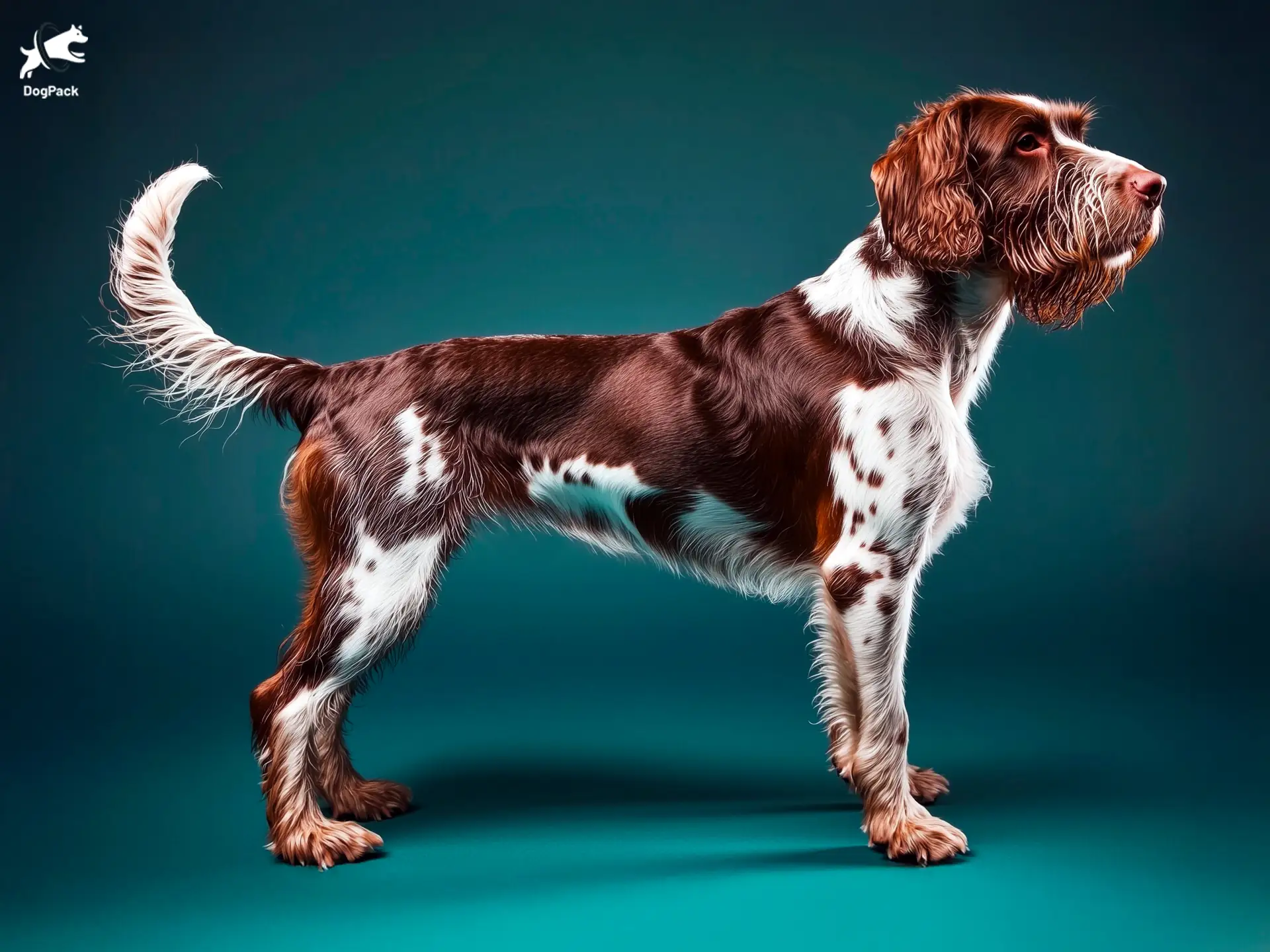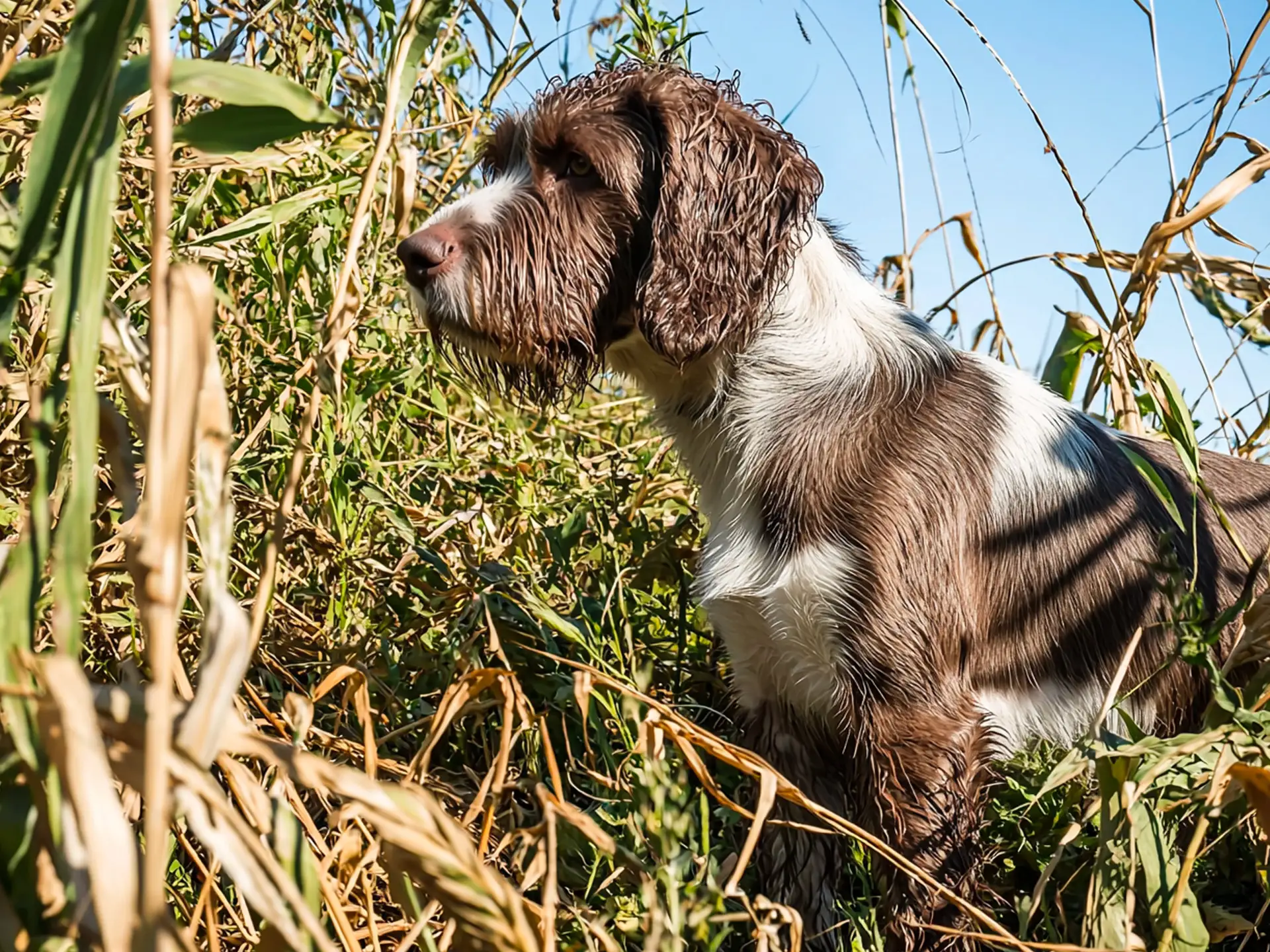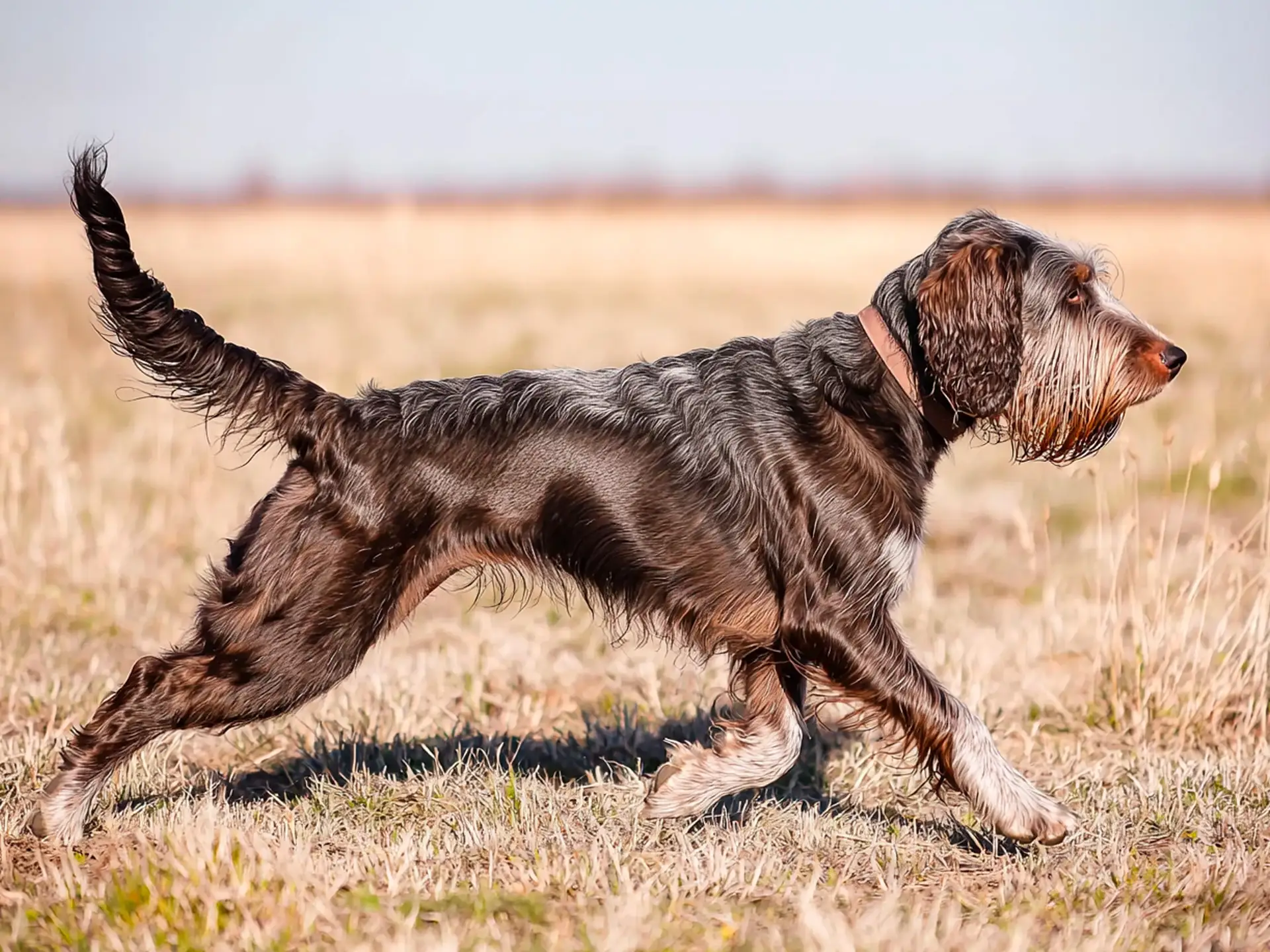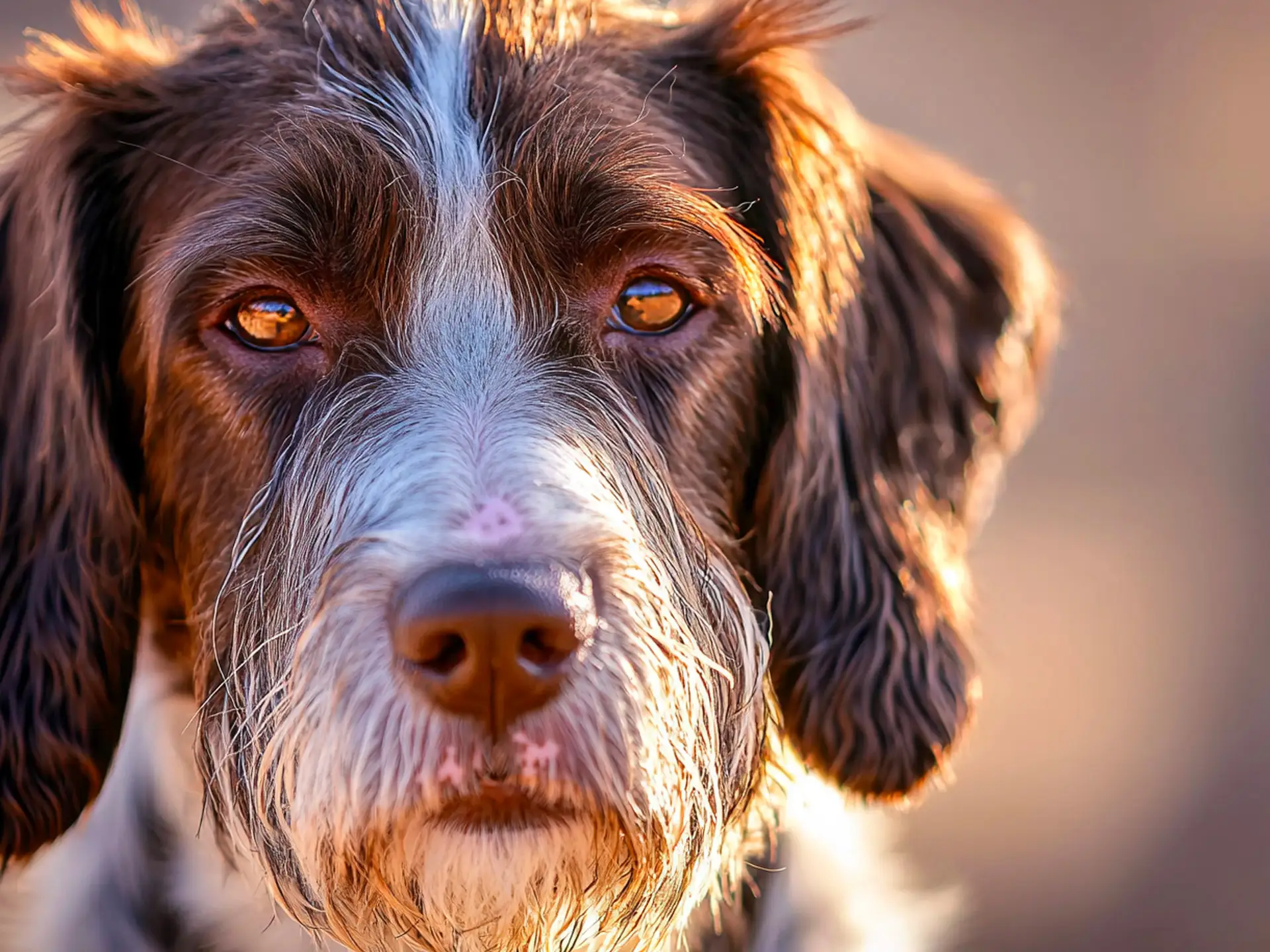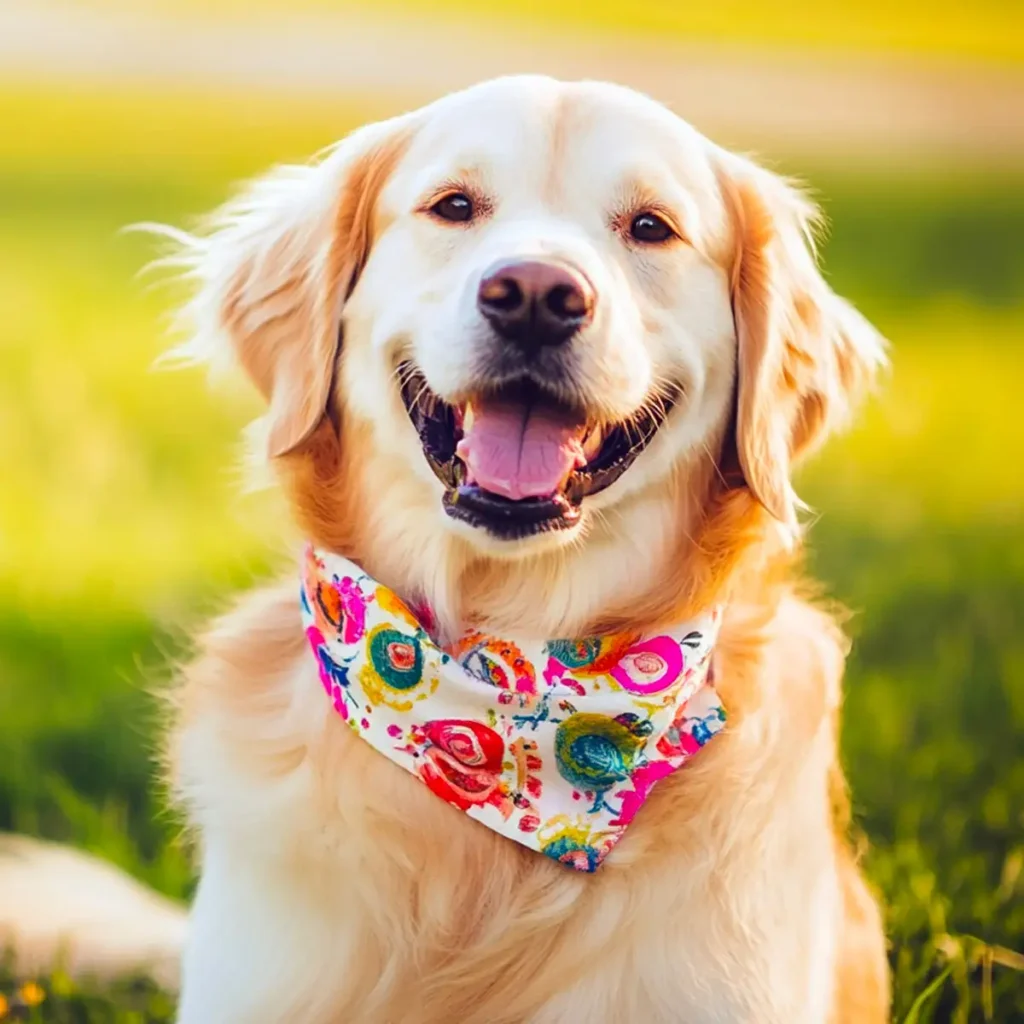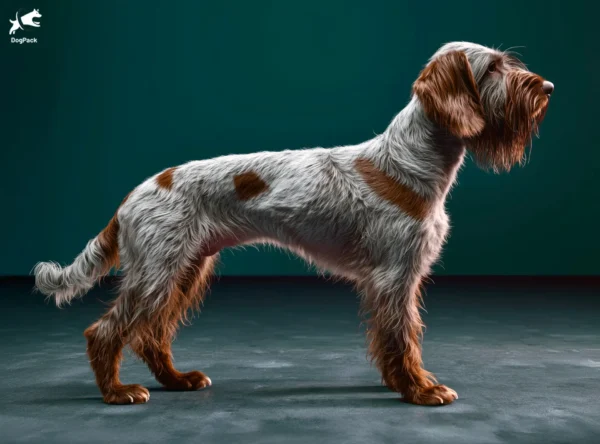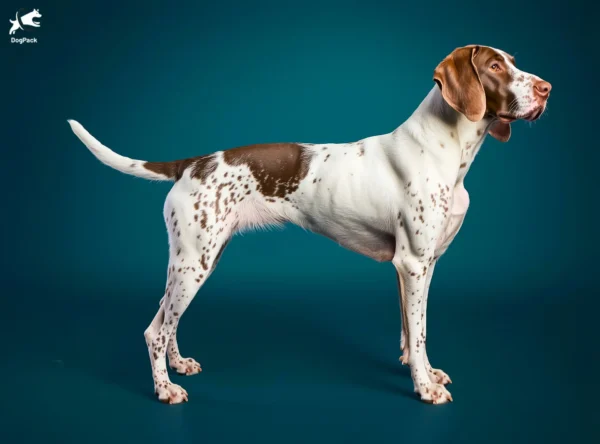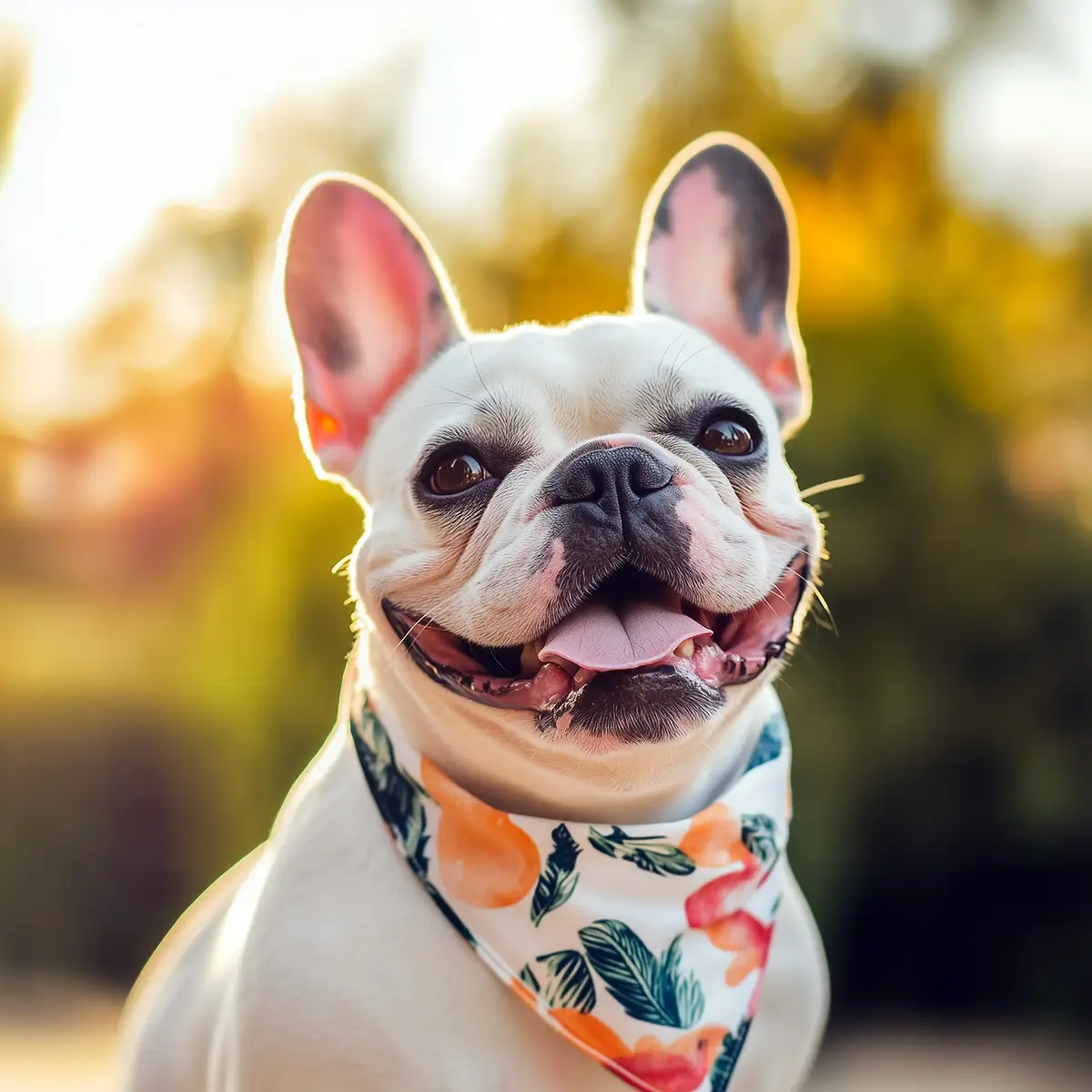German Wirehaired Pointer Dog Breed Info & Overview
The German Wirehaired Pointer is the definition of determination, energy, and rugged versatility. Bred for demanding hunts across fields, forests, and wetlands, this all-purpose sporting dog boasts the stamina of a marathon runner and the devotion of a lifelong companion. With its wiry coat, keen intelligence, and boundless enthusiasm, the German Wirehaired Pointer is a hardworking hunter and a loyal family friend.
Characteristics
Pictures
Breed History
Originating in late 19th-century Germany, this determined hunting companion was created by crossing several versatile gun dogs, including the Pudelpointer and Wirehaired Pointing Griffon. Breeders sought a rugged, all-around sportsman capable of tracking on land or water. The result was a dog with a keen nose, thick protective coat, and unyielding spirit that thrived in challenging terrains.
By the early 20th century, the German sporting community embraced this agile pointer for everything from duck retrieval to upland bird hunts. Its ability to adapt to various hunting styles made it a popular choice among dedicated outdoorsmen. As the breed’s reputation grew, so did its demand, eventually capturing the admiration of hunters and canine enthusiasts across Europe and beyond.
Although officially recognized by kennel clubs in the mid-20th century, the German Wirehaired Pointer’s exact lineage was never meticulously documented. However, its consistent performance in the field speaks volumes about the breed’s heritage. Over time, it also found a niche as a family pet, securing a legacy as both a tireless worker and a devoted companion.
Temperament, Personality
Spirited and ever-curious, these pointers have an innate drive to explore every corner of their environment. Expect them to greet every new day with enthusiasm, ready to chase scents or scope out potential mischief. Their confident nature often translates into a bold approach to life, making them excellent problem-solvers who won’t shy away from challenges.
Beneath that rugged exterior lies a deeply loyal companion who forms strong bonds with family members. They tend to be affectionate around people they trust, yet they can remain politely reserved with strangers. Early socialization is essential to channel their protective instincts appropriately, ensuring they grow into well-mannered, self-assured dogs ready to charm everyone they meet.
In a household with children, these dogs often thrive as playful yet watchful friends, though they appreciate respectful interactions. They can coexist peacefully with other pets, especially if introduced correctly, but their strong prey drive might call for supervision. Overall, German Wirehaired Pointers are devoted sidekicks with a zest for life, always seeking new ways to engage and entertain.
Physical Characteristics
One glance at this breed, and you’ll notice the coarse, wiry coat that serves as armor against rugged terrain and inclement weather. Their bodies are lean but muscular, designed for endurance and agility. The hallmark eyebrows and beard not only add a dash of dashing charm but also protect the face from brambles and debris while on the hunt.
Standing between 22 and 26 inches at the shoulder, they’re solidly built without appearing bulky. Their broad heads support keen eyes, typically amber or dark brown, that exude intelligence and alertness. A strong neck slopes into well-defined shoulders, setting the stage for a deep chest and powerful legs that handle rough fields as effortlessly as a manicured backyard.
German Wirehaired Pointers usually come in liver or liver-and-white combinations, often sprinkled with ticking or roaning patterns. Their tails, sometimes docked, are carried horizontally when in motion, reflecting the breed’s active nature. Overall, these dogs were engineered for functionality, every feature honed to excel in hunting while maintaining an appealing, rugged look that leaves a lasting impression.
Health Issues
Like many medium- to large-sized dogs, they can be prone to hip and elbow dysplasia, which may hinder mobility if left unchecked. Regular vet screenings and maintaining a healthy weight can help alleviate stress on joints. Another condition to watch for is ear infections, as their floppy ears and active lifestyles make them susceptible to trapped moisture and debris.
Some individuals may experience eye issues like cataracts or progressive retinal atrophy, so periodic ophthalmologic checks are a wise precaution. Bloat, also known as gastric torsion, can be life-threatening and is a concern for deep-chested breeds. Monitoring mealtime routines, such as avoiding intense activity immediately after eating, can reduce the risk.
In general, German Wirehaired Pointers are robust dogs if provided with regular health checks, balanced nutrition, and daily exercise. Owners should stay proactive about routine vaccinations, parasite prevention, and annual exams. By catching potential problems early, you can help ensure a long, active life for your dog, keeping them ready for adventures at every turn.
Grooming Needs
That wiry, double-layer coat demands regular upkeep to remain both functional and stylish. A thorough brushing at least once a week helps remove dirt and loose hairs, preventing matting around the beard and legs. Stripping or plucking the dead hair by hand or using specialized tools can keep the coat’s texture crisp and water-resistant.
Because this breed’s coat naturally repels debris, frequent baths aren’t typically needed unless they’ve had a particularly muddy adventure. When you do bathe them, opt for a mild shampoo to preserve the coat’s protective oils. Regular ear checks and teeth cleaning are also essential, as active dogs can pick up all sorts of grime on their daily excursions.
German Wirehaired Pointers also benefit from routine nail trims to keep their feet comfortable and prevent accidental scratching. Grooming sessions double as bonding time—use these moments to inspect for any lumps, bumps, or injuries. With consistent care, their distinctive appearance will shine, and you’ll have a clean, happy companion who’s always ready for the next outing.
Exercise Requirements
When it comes to staying active, these dogs never seem to run out of energy. They crave both physical and mental challenges, making them ideal companions for jogging, hiking, or agility courses. However, simply tossing a ball in the backyard might not be enough—engaging puzzle toys or scent-tracking games can help fulfill their innate desire to work and explore.
A solid guideline is at least one to two hours of exercise every day, split between structured play and free roaming. High-intensity activities like fetch in an open field or swimming sessions in a safe body of water will keep them happily worn out. Keep in mind, a bored pointer can turn your living room into an obstacle course.
Because German Wirehaired Pointers have hunting instincts to burn, consider involving them in field trials or scent work classes to truly harness their drive. These activities provide both a mental workout and physical release. Ultimately, the key is variety—mix up running, fetching, and problem-solving tasks so they remain engaged, preventing any restless or destructive behaviors at home.
Training Tips
These pointers are sharp-minded, but their independent streak can make training a lively affair. Consistency and patience are your best friends—once they understand the rules, they tend to catch on quickly. Positive reinforcement, especially treats or toys, will appeal to their keen intelligence, though it’s crucial to avoid harsh corrections that could undermine their confidence.
Early socialization is vital to help them navigate various scenarios, from meeting other animals to accepting guests in your home. Introduce them to different sounds, sights, and surfaces while they’re still curious puppies. This foundation fosters a well-rounded temperament, reducing the likelihood of overprotective or anxious behaviors down the road.
German Wirehaired Pointers excel in advanced tasks like pointing trials, obedience competitions, and even search and rescue missions if guided properly. The key is channeling their energy and intelligence into constructive outlets. Always remember, a bored pointer is more likely to find its own fun—often at the expense of your freshly planted garden or living room décor.
Nutrition, Diet
A high-energy breed like this thrives on a diet rich in protein and moderate fat, fueling their endless stamina. Look for premium dog foods formulated with real meat or fish as the main ingredient, while steering clear of fillers that offer empty calories. Their robust metabolism calls for nutritionally dense meals that can keep pace with a busy lifestyle.
For an adult German Wirehaired Pointer weighing around 60 pounds (27 kg), expect to feed roughly 2.5 to 3 cups of high-quality kibble per day, divided into two meals. Extremely active dogs may require slightly more, while lower-energy individuals can get by on the lower end. Always adjust portions according to your dog’s age, activity level, and overall body condition.
Incorporate variety with occasional lean meats, fish oils for coat health, and fiber-rich vegetables. Monitor how they respond to different ingredients, as some GWPs might have sensitivities to grains or certain proteins. Providing balanced treats for training is fine, but be mindful of the extra calories—these pointers can quickly pack on weight if overindulged, potentially impacting their performance.
Adoption, Breeders
For those interested in a well-bred pup, start by connecting with organizations like the German Wirehaired Pointer Club of America, which maintains a breeder directory. Reputable breeders screen for genetic conditions and emphasize proper socialization. This ensures you’ll receive a healthy, confident puppy with the traits and temperament you expect from this versatile sporting dog.
If you prefer adoption, check out breed-specific rescues such as Petfinder or local GWP rescue groups, where older dogs or those needing a second chance might be waiting. Adopting a German Wirehaired Pointer can be rewarding, as many mature dogs have basic training and social skills already in place, making the transition into your home smoother.
Before committing, research kennel reputations, ask questions about health clearances, and request to meet the mother dog if buying a puppy. Take note of the environment—clean, well-run facilities reflect responsible breeding practices. Whether you’re adopting or purchasing, investing time in finding the right match pays off, resulting in a loyal companion for years to come.
Family Pet?
Active families who love outdoor adventures can find an enthusiastic ally in these dogs. They’re always ready to join hikes, weekend camping trips, or even just a rambunctious backyard play session. Thanks to their affectionate yet protective nature, they can make wonderful watchdogs, alerting you to unfamiliar sounds without being excessively vocal or aggressive.
Socialized early, they generally get along well with considerate children, though supervision is advisable to prevent any rough play. Their sturdy build means they’re less likely to be easily injured by a child’s enthusiastic hug, but it’s still vital to teach kids respectful handling. This mutual understanding lays the groundwork for a harmonious, playful household.
German Wirehaired Pointers thrive when they can be part of the family’s daily activities. Leaving them isolated or lacking mental stimulation can lead to boredom and, eventually, creative mischief. If you can offer plenty of exercise, positive social interaction, and ongoing training, you’ll likely find them to be loyal, lively companions who enrich your family life.
Right For You?
Before bringing one home, assess whether you can dedicate ample time to exercise and mental stimulation. These pointers thrive in environments where they can roam, sniff, and engage in purposeful tasks. A small apartment might prove challenging unless you’re committed to daily high-energy outings. In the right setting, they truly shine as versatile, all-in-one companions.
These dogs are not content to laze around the house all day, so if your schedule keeps you away for long stretches, consider if another breed might be more suitable. They do best with active owners willing to invest time in training and socialization. In return, you’ll get a steadfast partner ready to share every outdoor escapade.
German Wirehaired Pointers suit those who appreciate a dog that can transition from serious worker to affectionate friend. Owners who relish canine companionship during hunting trips, jogs, and daily tasks will find them especially fulfilling. Ultimately, choosing this breed means embracing an energetic, loyal dog that demands your engagement and repays you with unwavering devotion.
Conclusion
Deciding whether to welcome a German Wirehaired Pointer into your life is all about understanding their boundless energy and keen intelligence. With enough exercise, consistent training, and positive socialization, these dogs can flourish in a home that values outdoor fun and mental challenges. Their loyalty runs deep, and they’ll repay your commitment with unwavering companionship. If you’re ready to embrace a spirited, versatile partner for both adventures and family time, this determined sporting breed might just be the perfect match for you.
FAQs
-
Why does my German Wirehaired Pointer have such a rough coat?
The German Wirehaired Pointer’s coat is designed for protection in harsh weather and rough terrain. The wiry texture repels water, burrs, and dirt, making it ideal for hunting and outdoor adventures. Regular brushing helps maintain its function and prevents matting.
-
Do German Wirehaired Pointers have webbed feet?
Yes! The German Wirehaired Pointer has webbed feet, which make them excellent swimmers. This trait, combined with their water-resistant coat, allows them to retrieve game from lakes, rivers, and wetlands with ease. Many love swimming and water-based activities.
-
Why does my German Wirehaired Pointer follow me everywhere?
This breed forms a strong bond with its owner and thrives on companionship. Bred as a versatile hunting partner, the German Wirehaired Pointer is naturally inclined to stay close to its human, whether indoors or out in the field. Training can help with separation anxiety.
-
Are German Wirehaired Pointers known for being stubborn?
Yes, German Wirehaired Pointers are highly intelligent but also independent, which can sometimes be mistaken for stubbornness. They respond best to consistent, positive reinforcement training and tasks that challenge them mentally and physically.
-
Why does my German Wirehaired Pointer have a beard?
The distinctive facial hair, including a beard and bushy eyebrows, serves a purpose. It protects their face from rough brush, debris, and harsh weather when hunting. It also adds to their expressive look, giving them a rugged yet charming appearance.
Breed Ratings
Quick learners, eager to solve problems, making advanced training tasks enjoyable for both dog and handler.
They love interactive games and outdoor romps, though they might lean toward more purposeful tasks than casual play.
A German Wirehaired Pointer brims with vitality and thrives on long walks, hikes, and high-energy play sessions.
Moderate shedding year-round, but weekly brushing helps keep stray hairs and dander under control.
Bred for hunting, they possess a strong instinct to chase, requiring mindful supervision around smaller animals.
Their wire coat needs regular brushing and stripping, but the natural texture repels dirt and water effectively.
They’re bright and responsive, but occasional stubborn streaks call for consistent, patient training methods.
Extended isolation can lead to boredom and destructive behaviors, so they’re best with active, present owners.
Generally alert but not excessively vocal; they’ll speak up if they sense a reason, especially when hunting.
Drool is minimal compared to other large breeds, though their bearded muzzle can hold onto water and food.
Early socialization is key, as they can be selective. Proper introductions help them get along with canine companions.
Robust overall, but proactive vet checks and mindful care can prevent common issues like hip dysplasia and ear infections.

